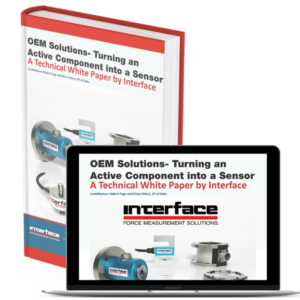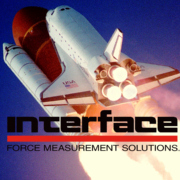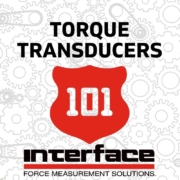New Interface White Paper Highlights Turning an Active Component into a Sensor
 The most common uses of force measurement in OEM (original equipment manufacturer) applications are when a force sensor is designed into a product that will be produced at mid to high volumes and provides real-time force feedback on certain product functions in use. Utilizing sensors as a feature enables data acquisition over time to monitor forces and understand how those forces effect product efficiency, safety, quality or all of these performance metrics. This ultimately is used to design a better product, in the current state and for future enhancements or to know when a product is performing best or risks breaking down.
The most common uses of force measurement in OEM (original equipment manufacturer) applications are when a force sensor is designed into a product that will be produced at mid to high volumes and provides real-time force feedback on certain product functions in use. Utilizing sensors as a feature enables data acquisition over time to monitor forces and understand how those forces effect product efficiency, safety, quality or all of these performance metrics. This ultimately is used to design a better product, in the current state and for future enhancements or to know when a product is performing best or risks breaking down.
Did you know that there is another application of force sensors in OEM applications that is playing a large role in the factory of the future? This is when we turn an active component into a sensor and use that data to create automated actions. This solution is used when there is a desire to take a moving component within a system and make it smarter, ultimately allowing it to make data-based decisions on its own.
For example, the manufacturing industry is using force sensors on machines within a production line that are responsible for picking components up for visual inspection. The sensor is integrated into the grabbing component and can tell the machine the exact force to use when picking up the component as not to damage it. This is a critical capability when dealing with expensive and delicate components that can break under too much force. In the past, a force measurement sensor would have been used only to test this functionality. When the sensor is designed directly into the machine, the user can both test beforehand and monitor and automate processes in real-time.
The need for this type of capability is growing rapidly amongst manufacturers across a wide variety of industry including aerospace and defense, industrial, medical, automotive, industrial automation, assembly and more. To further outline the potential for these types of solutions, Interface developed a new white paper that details how sensor solutions for OEMs work with specific examples of the benefit of turning an active component into a sensor.
Included below is a brief intro to the recently released white paper. Get your copy by clicking on the link here. Additionally, if you’re interested in learning more about Interface solutions for OEM applications go here, or call us to speak to our OEM application experts at 480-948-5555. Ready to get started, let us know how we can help here.
WHITE PAPER EXCERPT
OEM SOLUTIONS: TURNING AN ACTIVE COMPONENT INTO A SENSOR
The age of industrial automation and big data is upon us. Manufacturers that fall behind in equipping their facilities and products with innovation that allows for automated processes, remote monitoring and better efficiency through technology, will quickly fall behind. This is due to the fact that automation helps to significantly improve process quality because it eliminates human error. It also creates long-term cost savings by speeding up several processes, or by helping to monitor products in use and in real-time to optimize performance and stability over time through better data collection.
Get your copy of the white paper to read more.
Special note, contributors to the white paper are Interface and sensor engineering experts, Brian Peters and Rob Fuge.
Additional Resources for OEM
Interface is a Critical Solutions Provider for OEMs
Making the Case for Custom Solutions Webinar Recap








